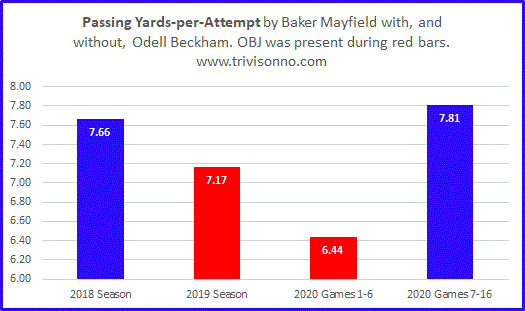As everybody now knows, Baker Mayfield plays much worse when Odell Beckham, Jr. is on the field. But exactly how much worse? If we examine the “yards per passing attempt” metric, OBJ taxes the Browns to the tune of 365 yards per season. Take a look at this chart:
So, during his rookie year in 2018, before OBJ joined the Browns, Baker averaged 7.66 yards per throw. When OBJ joined the team in 2019, that number dropped to 7.17. OBJ only played the first six games of 2020 before being injured, and during those games Baker’s average dropped some more, down to 6.44. But, as soon as OBJ was gone, Baker went off like a rocket, averaging 7.81 for the remainder of the season.
For the entire 2020 season, in this metric, Baker ranked at #17 with 7.3 yards-per-attempt. However, without OBJ there to distract him, he likely would have ranked at #8. That’s the difference between being ho-hum and being elite.
Combining the data from Baker’s three seasons, we find that he has averaged 7.72 yards per pass attempt without OBJ, and 6.99 with OBJ.
So, OBJ has cost the Browns 0.73 yards per pass attempt. That doesn’t sound like much, but suppose that Baker makes 500 pass attempts in a season. That would give us a total of 365 yards (500 * 0.73). Spotting an opponent 365 yards would theoretically translate into almost 5 touchdowns.
Of course, when you employ a player like OBJ, you expect just the opposite. In fact, if OBJ added 5 touchdowns, you would probably consider that to be a lackluster performance. So, going from expecting +5 touchdowns, but only getting -5 is a 10-TD swing in expectations, at least.
Rather disappointing, but only if your goal is to win games. If your actual goal is to rub shoulders with a celebrity, then perhaps you might think 10 touchdowns is a small price to pay to hang out with Odell.
